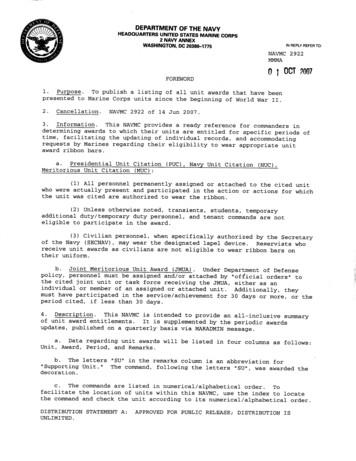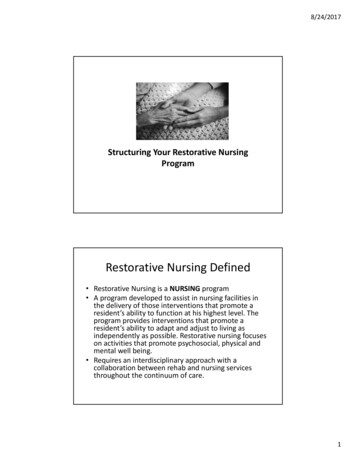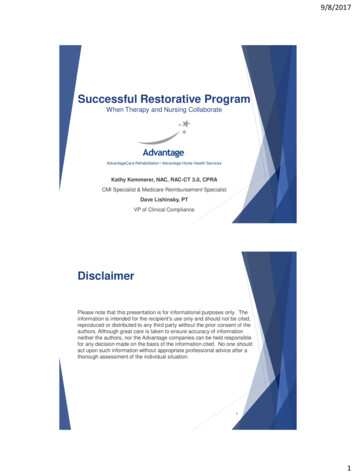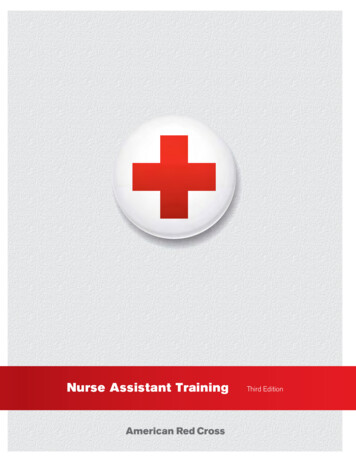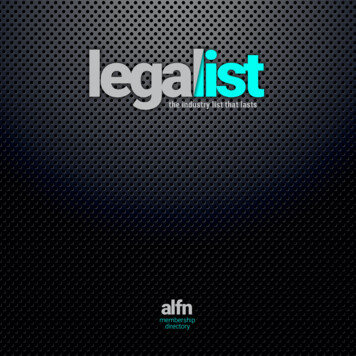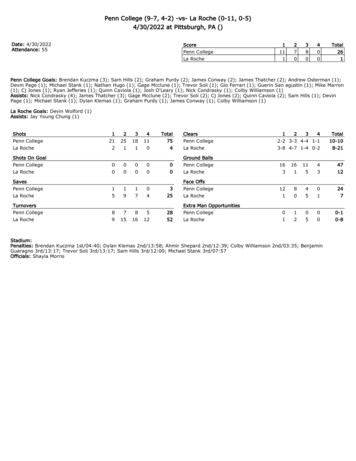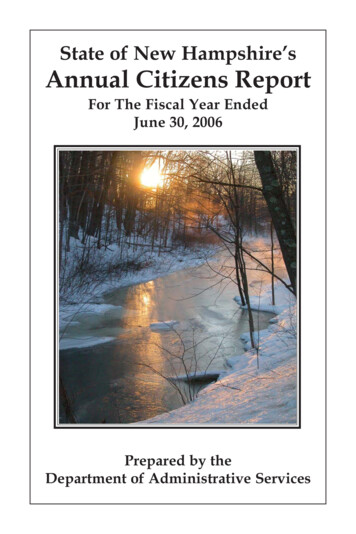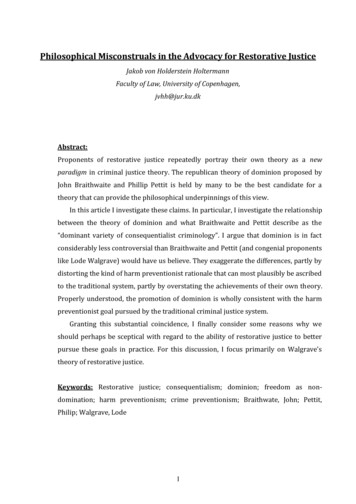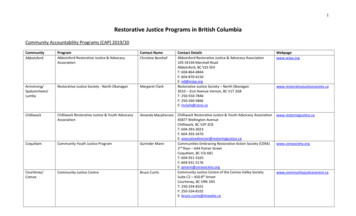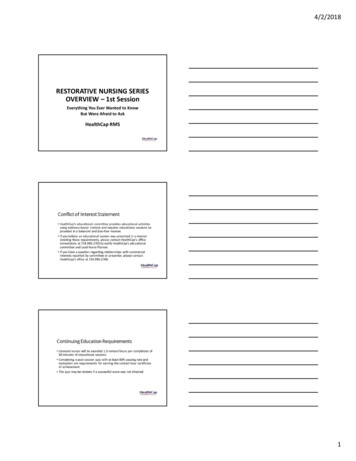
Transcription
4/2/2018RESTORATIVE NURSING SERIESOVERVIEW – 1st SessionEverything You Ever Wanted to KnowBut Were Afraid to AskHealthCap RMS1
4/2/2018Learner Objectives Evaluate the need for a restorative program Design a restorative program Compare restorative program optionsOBRA GuidelinesDefine restorative nursing as the continuation of therapy by nursingfollowing rehabilitation with nursing responsible for both maintainingthe status of the resident after discharge from rehabilitation anddocumenting efforts to restore as much functional independence aspossible.2
4/2/2018Restorative and ReimbursementRestorative Nursing Programs are a component of the following threeRUG categories Rehabilitation Behavioral Symptoms and Cognitive Performance Reduced Physical FunctionWhat is Restorative Nursing? Nursing interventions to promote a resident’s ability to adapt andadjust to living as independently and safely as possible Actively focuses on achieving and maintaining optimal physical,mental and psychosocial functioningWho Is It For?A resident may be started in a restorative nursing program when: Admitted to the facility with restorative needs but not a candidate forformalized rehabilitation therapy When restorative needs arise during the course of a long‐term stay orin conjunction with formalized rehabilitation therapy3
4/2/2018Generally SpeakingRestorative nursing programs are often initiated when a residentis discharged from formalized physical, occupational or speechtherapy and remains a resident of the facility/communityRestorative Nursing ProgramsDefined by MDSH0200, H0500, O0500Technique and Training and SkilledPracticeTechniqueActivities Provided by Restorative Nursing Staff O0500A, O0500B Passive and/or active range of motion** O0500C, Splint or Brace Assistance**Count as one service even if both provided (MDS 3.0 Manual 6‐48, October2015)4
4/2/2018Training and Skill PracticeActivities including repetition, physical or verbal cueing, and/or tasksegmentation provided by any staff member under the supervision of alicensed nurse. O0500D,O0500F ‐ Bed mobility and/or walking training** O0500E ‐ Transfer O0500G, Dressing and/or grooming training O0500H ‐ Eating and/or swallowing training O0500I ‐ Amputation/Prosthesis Care O0500J – Communication**Count as one service even if both provided (MDS 3.0 Manual 6‐48, October 2015)Toileting Programs – Separate Category H0200C ** ‐ Urinary toileting program H0500 ** ‐ Bowel toileting program**Count as one service even if both provided (MDS 3.0 Manual 6‐48, October 2015)Components of a Restorative Program Measurable objectives established for activity performance Interventions documented and care planned Licensed nurse evaluates program including documentation on ascheduled basis Staff members trained and supervised by a licensed nurse5
4/2/2018Role of Restorative Nurse Aides Under the supervision of the licensed Restorative Nurse the RNAsprovide and assist in delivery of restorative services. Can include swallowing techniques at mealtime for specific residentsas recommended by speech therapy. RNAs are responsible for monitoring and documenting the resident’sprogress or regressionEvaluating the Need forRestorative ProgrammingAlso known as – improving resident functional statusand CASPER report ratingsThe Facility Assessment Your Facility Assessment should be used The Facility Assessment should provide you with an overview of yourresidents’ specific needs It should also identify your areas of expertise6
4/2/2018Evaluate the Hazards of Immobility Musculoskeletal System Cardiovascular System Integumentary System (Skin) Respiratory System Genitourinary System Gastrointestinal System Central Nervous SystemImmobility and DependenceOlder adults fear the loss of mobility and independenceFunctional Dependence Bedfast Eating dependent Transfer dependent Incontinent7
4/2/2018Not Only Negative for ResidentQuality Measures for the STAR rating and CMS Nursing Home Compare(available for consumers and prospective residents) use: Increased ADL needs Falls and falls with major injury Low‐risk incontinence UTIs Pressure woundsEvaluating the Need ‐ Choosing the Leader A licensed nurse Able to direct care and supervise staff Able to MOTIVATE the staff to work with unmotivated orunderachieving residents Creative and innovative ONGOING Professional Development to keep the programs freshDesigning A RestorativeProgramAction steps to improve performance8
4/2/2018MDS O0500 Restorative Nursing Program Requires 15 minutes in a 24 hour period; ONE program can be totaled across the 24‐hour period Each program must be separate Cannot combine minutes of two or more programs Groups of 4 or less per caregiverSuccessful Programs Integrate specialty therapy, RNs and CNAs working with clearrestorative therapy responsibilities Document the resident’s restorative needs on the MDS Develop and tie resident specific care plans back to the MDS Program objectives are realistic and achievable with respect toresident needs and caseloadProgram Implementation Evaluation of need determines priorities, benchmarking, and goals Which existing staff are the “best fit” for restorative?9
4/2/2018Program Implementation Based on the evaluation priorities determine how many RestorativeTeam members are needed How many programs will run on each shift How many Restorative staff will be needed each shift Determine how many staff need to be trained on each shift Establish a standardized training and competency verificationprogram for the Restorative Nurse Assistants (RNAs)Program Implementation Plan and communicate discharges from therapy to provide an RNAand Restorative Programming Train CNAs to support restorative by managing basic care needs toallow RNA focus on the continuity of servicesImplementation – The Moving Parts Therapy should be involved in resident assessment, determination ofrestorative needs, training nursing staff, identifying feeding programcandidates, etc. The goal is to have as much specialty therapy involvement as possiblewithout limiting resident care Each resident with restorative needs should be evaluated by nursingand therapy and classified into one of four categories10
4/2/2018Remember! The restorative program must meet the criteria in O0500 to code iton the MDS Some programs may be good for the resident and should continueeven if they do NOT meet the MDS Restorative criteriaDocumentation Measurable objectives/interventions Goals should be specific to that resident and to what you are tryingto achieve with that programDeciding How to Make theProgram Work in Your HomeCompare RestorativeProgram Options11
4/2/2018Comparing Programming Options Use your needs assessment to determine the priorities andimplementation plan What do your residents need?Categories of ResidentsCategory 1 Active ParticipantsCategory 2 Maintenance ParticipantsCategory 3 Residents Awaiting Active StatusCategory 4 Discharged ResidentsCategory 1 – Active Participants Active participants receive care from RNAs under the oversight oftherapy Most have been discharged from rehabilitation and requirecontinued support with: Ambulation Orthotic daily wear Feeding assistance, etc. Residents requiring orthotic devices should be evaluated by skilledtherapy to establish a wearing schedule and released to nursing forcare plan development12
4/2/2018Category 2 – Maintenance Participants Have been following a restorative care plan for several weeks withgood compliance and established progress/maintenance Care consists of: Ambulation assistanceRange of motion (massage and slow, gentle stretching MSGS)Proper positioning and functional alignmentOrthotic device application and removal.Category 2 – Maintenance Participants Maintenance care plans have a clear delineation of responsibilitiesregarding time schedules, etc. Care plans are prepared and signed by the CNAs responsible forimplementing the restorative care Care plans should be reviewed and updated as needed RNAs should carefully monitor each maintenance participants statusongoingCategory 3 – Residents Awaiting ActiveParticipant Status Residents with identified restorative nursing needs who are awaitingactive participant status receive short‐effects restorative therapyfrom trained CNAs This care is documented on the resident care plan13
4/2/2018Category 4 – Discharged Participants Participants are discharged from the program for various reasons When a resident is discharged and readmitted, an evaluation isindicated as the resident’s condition can change significantly whenrestorative therapy is not provided daily Active or maintenance participants who progress significantly mayqualify for discharge from the restorative program and admission torehabilitationCategory 4 – Discharged Participants Alert and oriented restorative program participants have the right torefuse treatment If participants are combative or uncooperative, maintenance statusmay be indicated Documentation as to the reasons a participant with cognitivedifficulties is discharged from the program should be in the medicalrecordProgram Option Examples Full program operating in dedicated restorative space and equipment Many residents receiving services in the restorative space as well astheir rooms A full program requires the RNAs be well trained and supervised Restorative programming generally occurs during 1st and some of 2ndshift at least 6‐days per week14
4/2/2018Program Option ExamplesSome homes provide specific portions of Restorative Nursing such as: Restorative Dining Walking Program Splint ProgramDocumentation ExamplesElectronic Health Records EHRs generally have systems for capturing Restorative Nursingservices Include Restorative Nursing documentation review in the QAPIand/or Corporate Compliance process Educate Restorative Nursing Assistants AND Certified NursingAssistants on documentation protocols15
4/2/2018FYI: Terminology and Coding Care plan language must match the MDS 3.0 If you use language such as Stand By Assist (SBA) and other therapyterms, define them in a key or glossary A RESTORATIVE PROGRAM IS A NURSING PROGRAM AND SHOULDUSE NURSING LANGUAGEDocumenting Restorative Care Increments of 15‐minutes per technique during a 24‐hour period 10 minutes PROM in morning; 5 minutes PROM in evening 5 minutes of splinting morning, afternoon and evening 15‐minute increments CANNOT be obtained by totaling differenttechniques over 24‐hoursRestorative Care PlansMeasureable objective and interventions must be documented in thecare plan and in the medical record.16
4/2/2018Goals – Do Not Support Services Resident A will maintain current weight Resident B will do 8 arm flexes two times a day Resident C will maintain current strength and flexibility Resident D will be clean, dry and odor freeRestorative Nursing Care Plans – Example #1Goals:1. Dressing/grooming ‐ Resident will complete ADLS with limited staffassistance2. Walking training ‐ Resident will move through the environmentwith staff assistanceApproaches: Resident will perform morning/evening ADLs with limited assistanceand set up qd 15 minutes Resident will walk/wheel with staff supervision qd x100 feet x15minutesWhat’s Wrong With Example #1?Goal #1 is identified as related to Dressing or Grooming Training. The actual goal states will complete ADLs with limited assistance. There is no description of which ADLs.17
4/2/2018What’s Wrong With Example #1?Goal #2 is related to Walking Training; the goal states will move aboutenvironment with supervision. What does this mean? How can we better describe our process and measure outcomes?Acceptable Goals ‐ Examples Resident A will walk 100 feet in five minutes with assist of one androlling walker Resident B will feed self finger foods at 50% or more of meals Resident A will open the fingers of her left hand far enough to hold aspoon (or tennis ball or some other object) Resident C will button the buttons on her shirt with step‐by‐step cuesMore About Acceptable Goals The goal needs to link directly to the TECHNIQUE It must logically flow from the TECHNIQUE, to theINTERVENTIONS/APPROACHES Include the HOW and WHERE/WHEN (time references)18
4/2/2018Periodic RN Evaluation Documentation Should be comprehensive; avoid “met goals, continue program” Instead: The goal was the resident would be able to walk 100 feet independently withher walker with cues and encouragement. She has demonstrated this ability every day for the past two weeks. Staff believe she has potential to walk farther however she is afraid andwon’t attempt to walk further if staff aren’t with her. Will revise program to increase the number of feet she walks with cues andencouragement. Will meet with her weekly to talk to her about her fears and talk to her abouthow much she is achieving.Scenario #1Mr. V lost ROM in right upper extremity: Right hand splint Right hand ROM exercises 15 minutes a day on splint; time is documented 7 days/week 15 minutes a day on ROM; time is documented 7 days/week The goal “will open fingers far enough to insert baseball” is in therecord There is documentation of CNA training on interventions The RN has documented supervision of the programScenario #2 Resident is independent in walking but has frequent falls PT works with the resident on strengthening exercises PT discharges resident with goals met Resident receives reminders from staff to complete exercises;documented by CNAs BID RN evaluates the resident’s progress and recommends program bemaintained19
4/2/2018Scenario #3 Resident is independent with walking however experiences falls dueto poor balance PT works with the resident on balance exercises Resident requires constant cueing to complete exercises CNAs are taught the exercises and how to cue the resident CNAs document time spent cueing resident BID, 5 days/weekSummary Needs of individual residents are addressed Measurable goals reflect the function the resident is currentlyworking on improving Criteria outlined in the RAI manual must be metConclusions An organized restorative nursing program is not as complicatedas it may seem The easiest and most desirable programs emphasize preventionand are designed to maintain physical and mental health, properpositioning and body alignment Restorative programs should have a constant emphasis on adignified, home‐like atmosphere and be resident centered20
4/2/2018What To Do NOW?1. Needs assessment – review the current program2. Include assessment of residents, staff, environment and equipment3. Prioritize using findings from the needs assessment and yourCASPER Report4. Choose the staff, arrange the environment, order the equipmentAND educate, educate, educate5. Implement low and slow – get it right before expandingprogrammingResources Handouts.pdf tive‐nursing www.thefreelibrary.com/Restorative nursing programReferencesAcello, B. The Long Term Care Restorative Nursing Desk Reference, HCPro, Inc., 2009.CMS Long Term Care Resident Assessment Instrument 3.0 User’s Manual, Version 1.13, October omeQualityInits/MDS30RAIManual.htmlMartinson, M. Restorative Nursing Coding on the MDS. Minnesota Department of Health. tiveNursingHandouts.pdfOffice of Inspector General Review of Restorative Programs, September .pdf21
MDS O0500 Restorative Nursing Program Requires 15 minutes in a 24 hour period; ONE program can be totaled across the 24‐hour period Each program must be separate Cannot combine minutes of two or more programs Groups of 4 or less per caregiver Successful Programs

